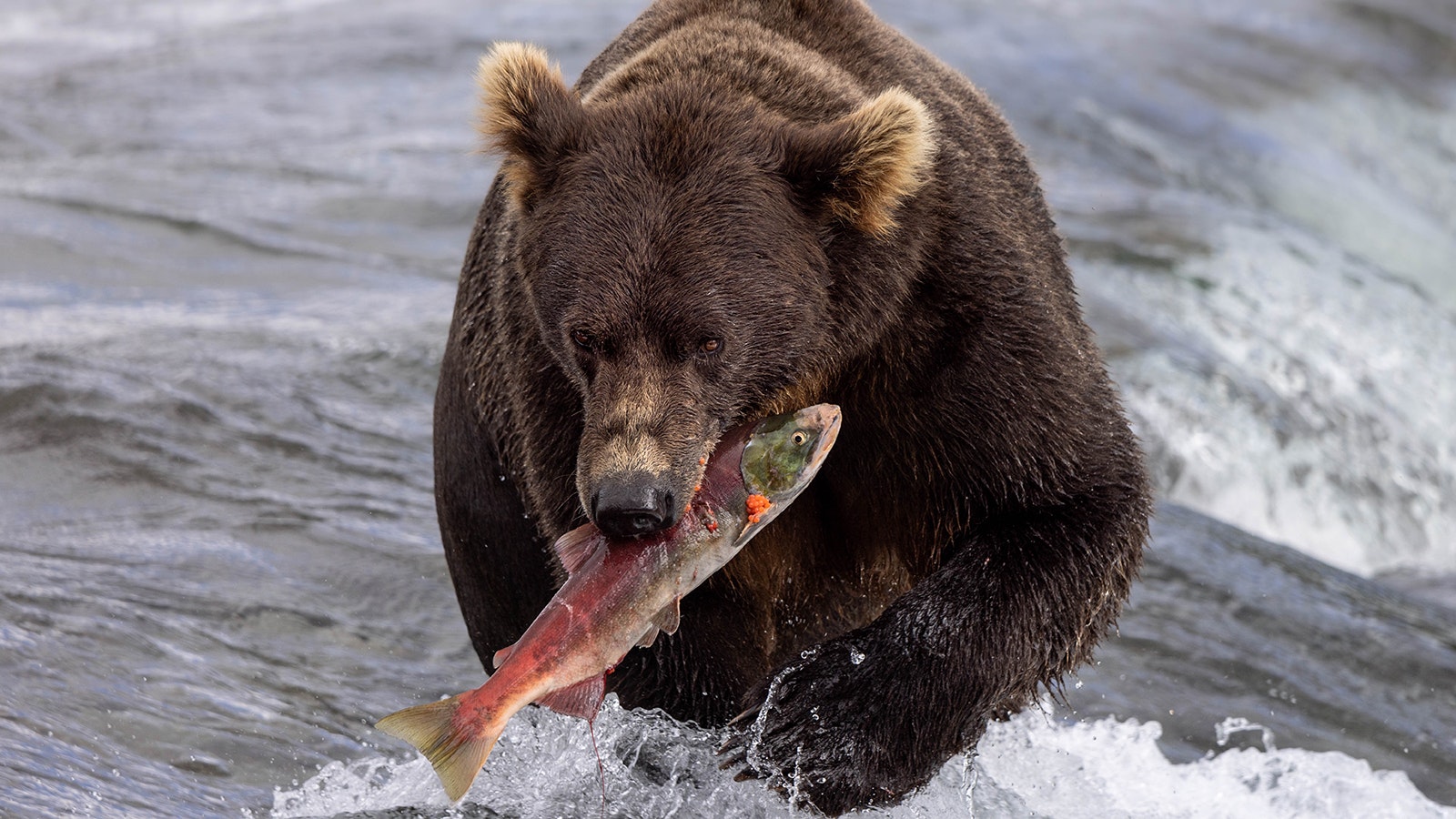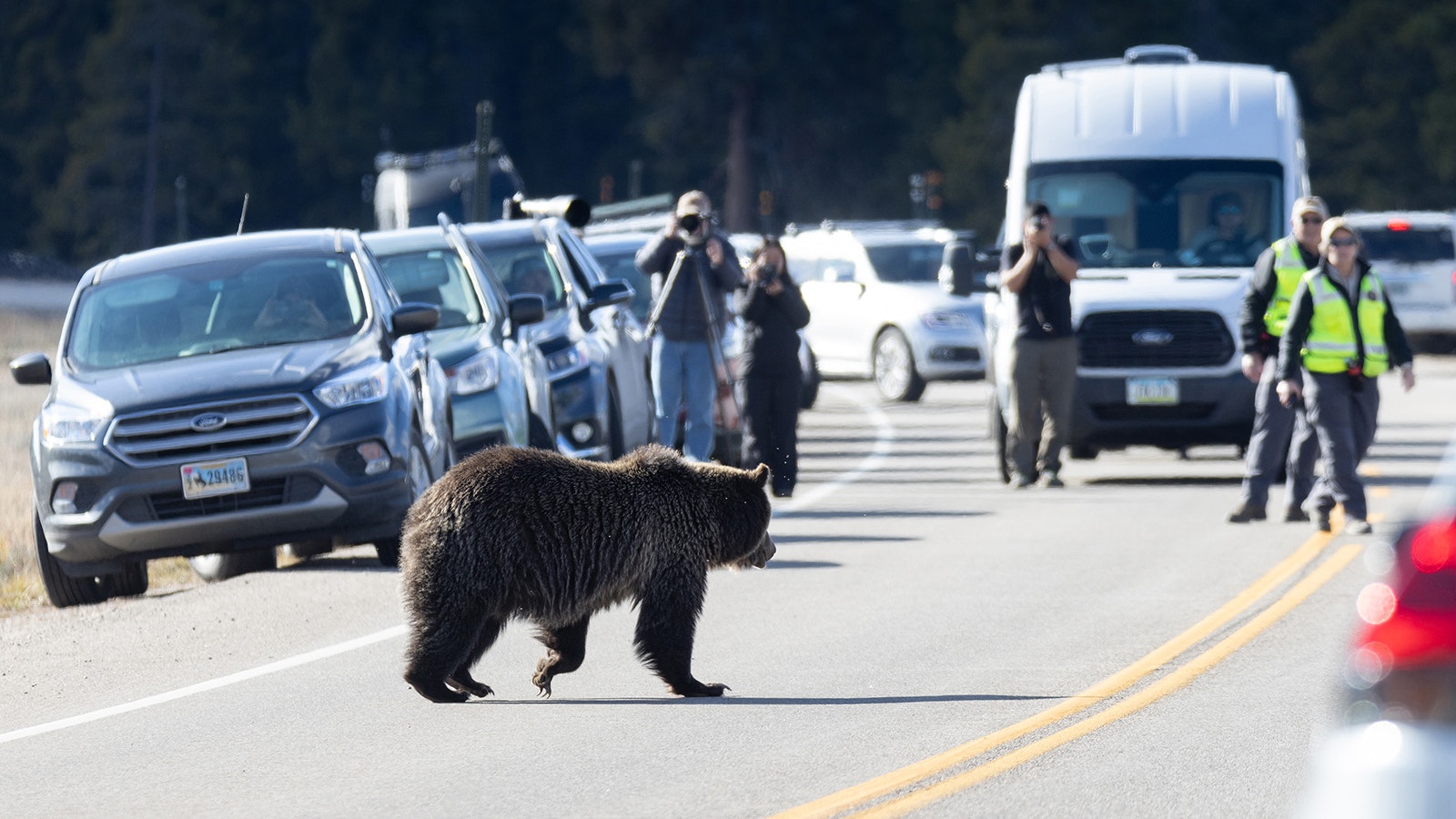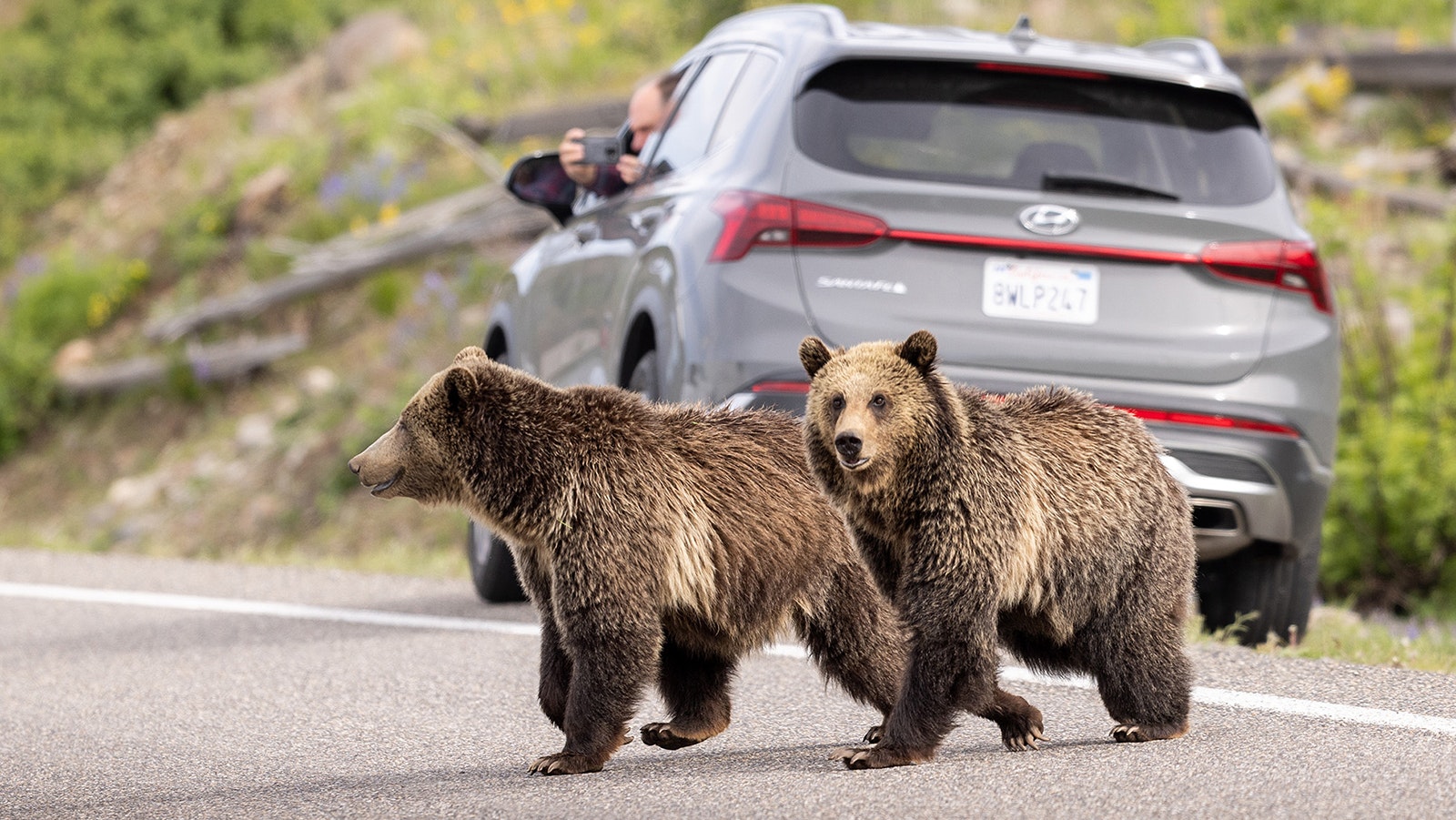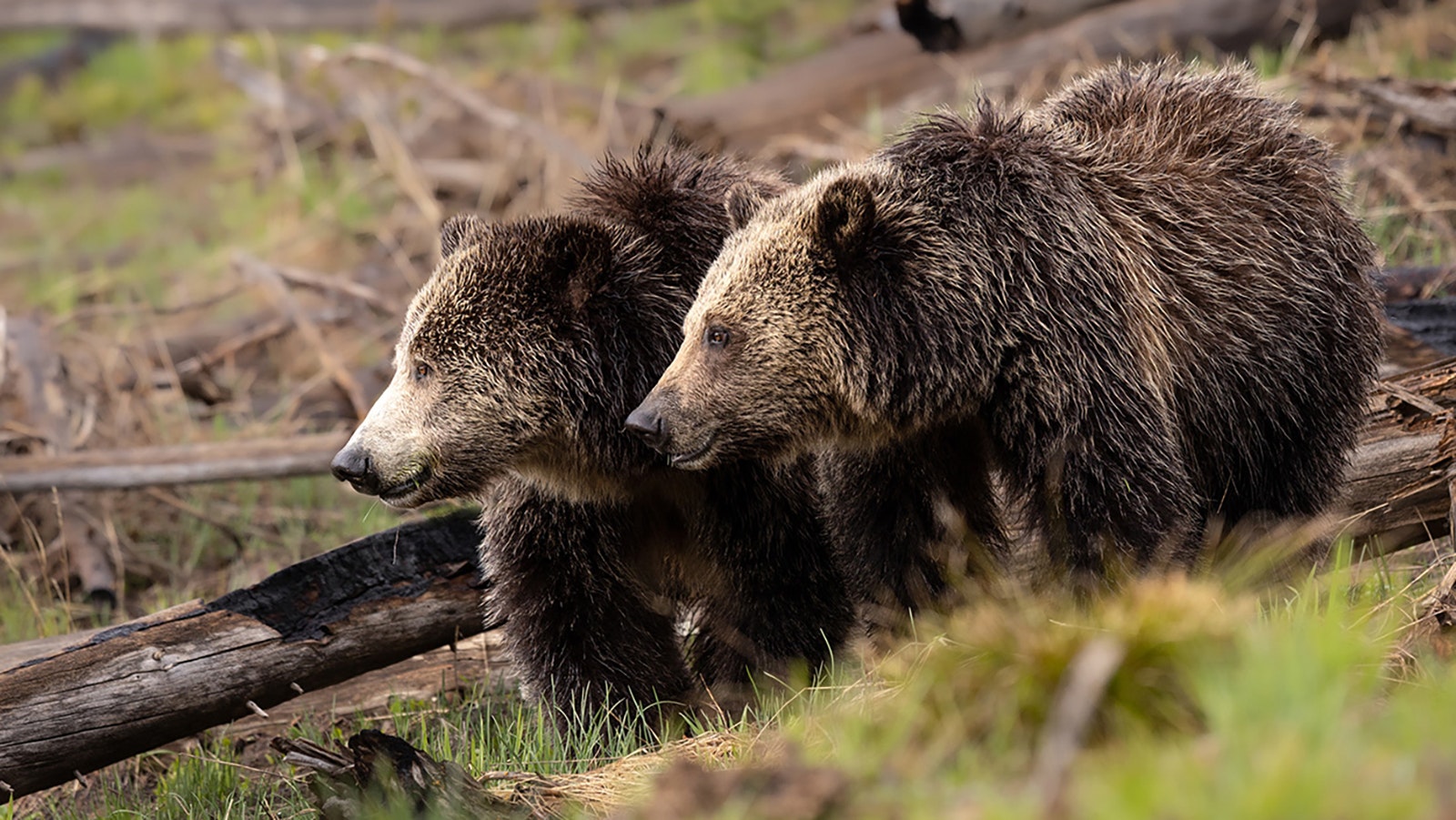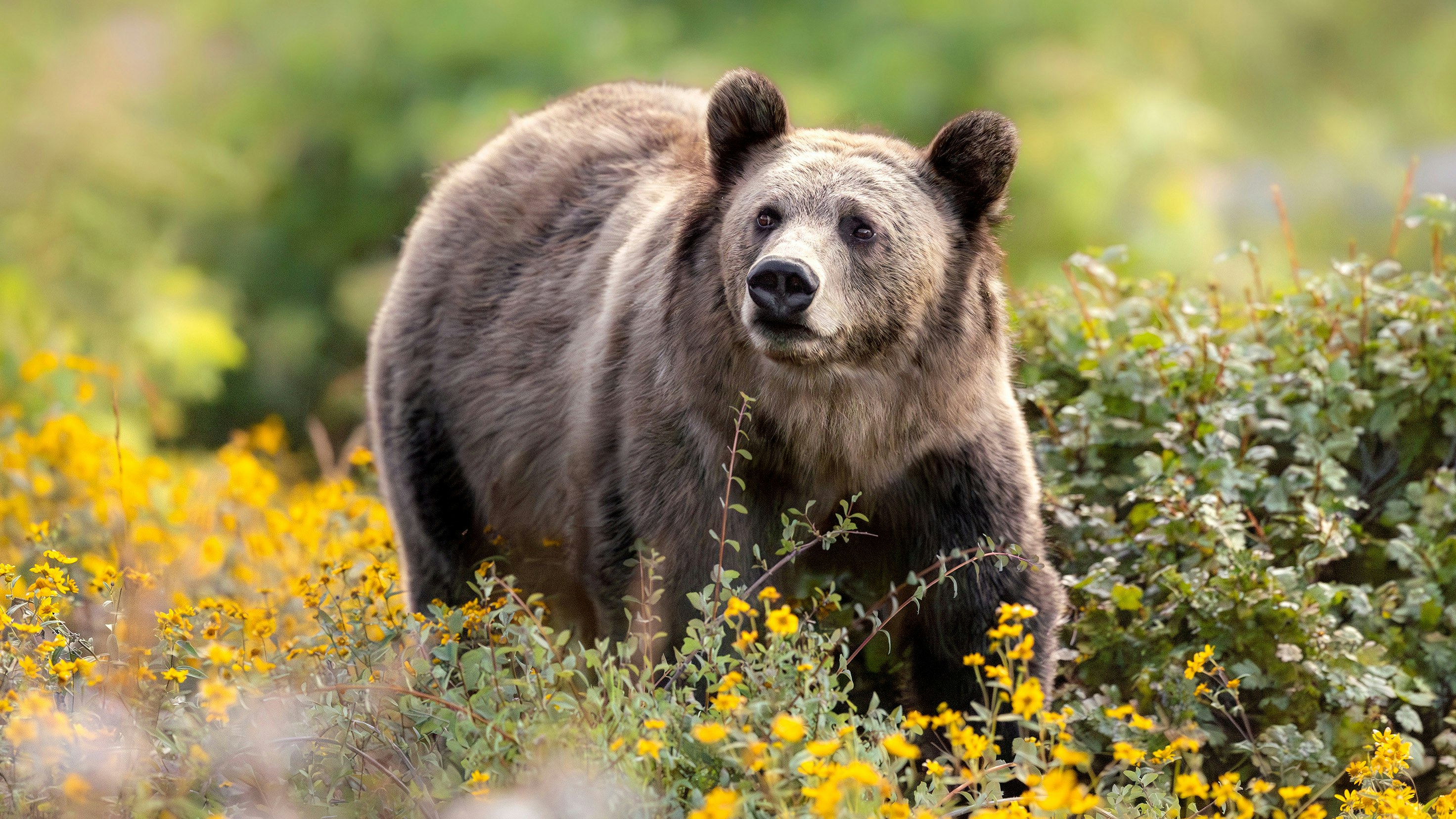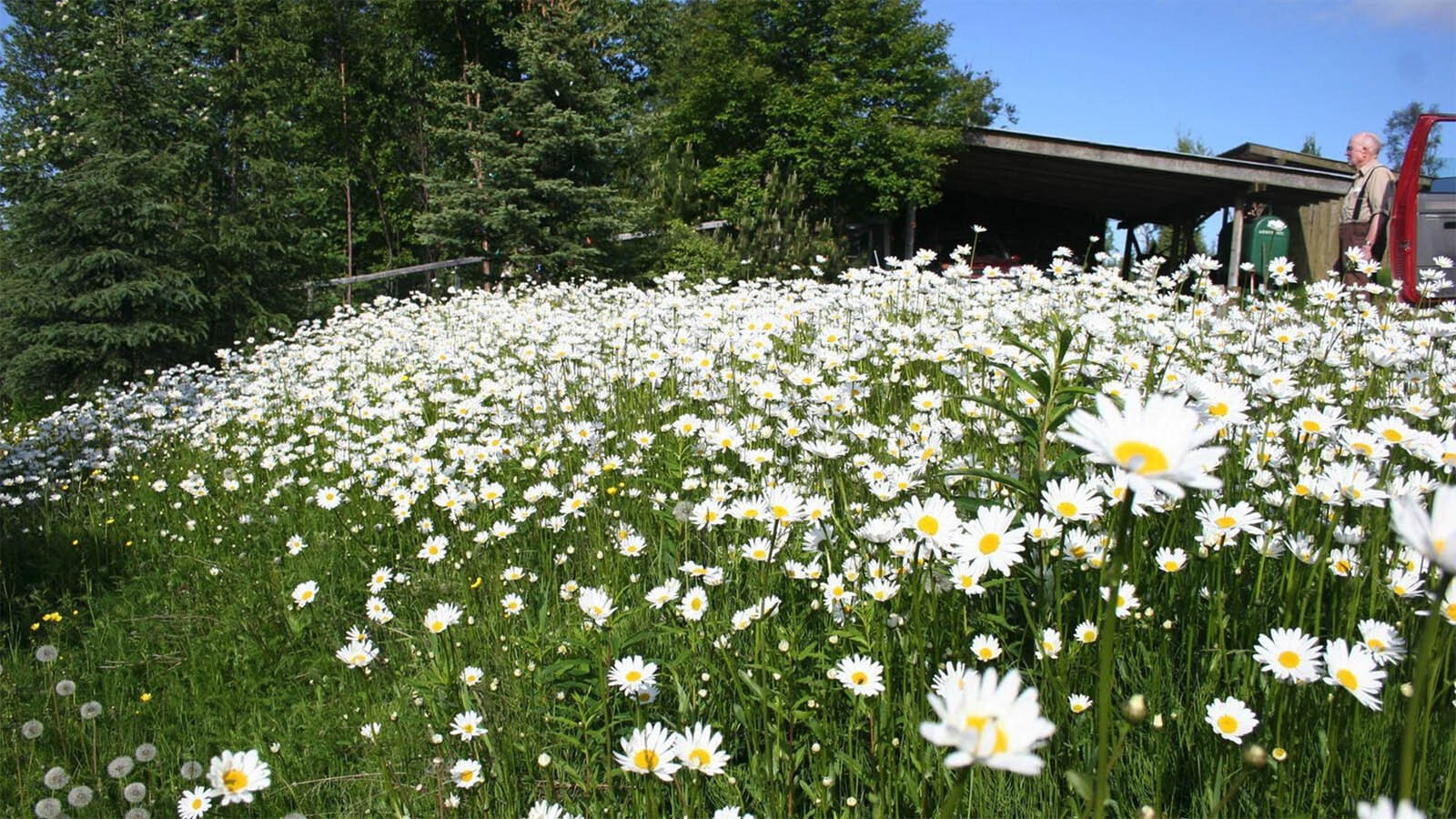When Cody wildlife photographer Julia Cook traveled to Alaska to photograph bears, her goal was to capture a Kodiak with a sockeye salmon in its mouth.
Having arrived in fall 2022 toward the end of the salmon run, however, Cook wasn’t sure if it would happen. Then one day while out shooting, she came across a lone bear actively fishing in the falls and waited.
“He was having a terrible time fishing, a fish would jump over here and he'd be so far in the other direction,” she told Cowboy State Daily. “ After about five or six attempts of him trying to catch a fish, he was finally successful, and it was that red sockeye salmon.”
Cook got her image, and it’s one of 12 that ended up being featured as part of her photojournalism project, “This is Grizzly Bear Country: Human Grizzly Interactions from Yellowstone to Alaska,” which she completed as the 2022 Larsh Bristol Photojournalism Fellow at the University of Wyoming and has continued to add to since.
The project highlights the complex ways humans and bears interact within a shared landscape, with images showing the possibility of coexistence.
“Many people see bears in a negative light, but I want to show that they are not only a little misunderstood, but can also be very beneficial to the state of Wyoming,” Cook said in a synopsis for her project. “The Larsh Bristol Fellowship gave me a purpose to go to Alaska and Yellowstone [National Park]. I was relieved to go there knowing I had the personal and financial support of others.”
Bears And Humans
The Larsh Bristol Photojournalism Fellowship provides a stipend for University of Wyoming students to showcase strong visual storytelling.
Cook was hesitant to apply at first because she was studying environment and natural resources, as well as history, and the fellowship was through the photojournalism department.
“I'd never taken any photography classes or really had anything to do with that program, but a couple of my professors who knew that I did photography recommended that I just apply for it,” she said.
Cook did and she was awarded the fellowship. She said part of her idea came because of the work she’s done at the Buffalo Bill Center of the West.
As a volunteer in the Draper Natural History Museum for the last six years doing specimen prep in the lab, Cook helped prepare specimens to be archived or displayed in the museum. During her time there she has worked with several animals, including bears, wolves and mountain lions.
“I've worked hands-on with a lot of bears that have met their demise through human-wildlife conflict,” she said. “So, a bear that had gotten into cat food that was not stored properly at a cabin and that had to be euthanized, and one that got hit by a car on the North Fork.”
Seeing the negative impact that people have on bears, Cook wanted to illustrate that while also demonstrating that the two can coexist.
Before the fellowship, Cook photographed grizzly bears as a hobby, but usually cropped out nearby roads and people. But she realized many people don’t understand just how close grizzly bears are to human life, and she took it upon herself to document how the species interact.
Wyoming and Alaska are two of the prime places on the planet to do that.
“I was getting comments through social media from people asking, ‘How far are you hiking into the backcountry to photograph these bears?’ And I don't really hike to photograph bears,” she said. “They're all roadway bears. I wanted to show how accessible bear viewing can be, especially here in Yellowstone.”
Searching For Grizzlies
Cook spent about three days a week from May through mid-July 2022 photographing bears in Yellowstone.
Many of her photos show grizzlies crossing roads. She photographed some bear management by park rangers as well, such as hazing or setting out cones to block a path for bears to cross a road. In one photo, Cook’s boot print is pictured alongside a grizzly track, “showing that we share the same rivers, mountains and trails.”
She tried to get through the East Entrance to the park before sunrise or go up later in the afternoon to avoid crowds. As is typical in wildlife photography, her success at finding her subject varied. Some days she’d see absolutely nothing and others she’d drive in and immediately find a bear.
“I really enjoy photographing the bears,” she said. “Their facial expressions are so interesting and they have different personalities. Any day that’s been a good day I spend most of my drive home just being excited to get home and put those photos up on my computer and look at them closer.”
Cook’s favorite grizzly to take photos of in the park is the 9-mile sow, or Snow as she is fondly called by many.
“I've been photographing her since she was a subadult just recently on her own, and this past year she had cubs for the first time,” she said. “It was really cool photographing her in that new motherhood role and seeing how her behavior changed with the cubs to have that protective instinct.”
It seems fitting that Cook’s favorite Yellowstone grizzly photo is of Snow. It was taken in August 2023 after her official project was completed.
“That tends not to be the best time for bears since it is so hot,” she said. “But my favorite bear was walking through these yellow wildflowers and it was just such a beautiful moment.”
Any Bear Is A Great Bear
And while Snow is her favorite, she said it’s a thrill to see new bears as well.
“There are some people that will only photograph the bears they see regularly, or the numbered bears in the park like 399 in the Tetons, but more recently I've almost gotten more excited when it's a bear I haven't seen before,” she said. “I get excited just knowing how many bears are in this ecosystem and how many bears are out there that may never really even encounter people because they're so far in the backcountry.”
She doesn’t consider herself a patient person who will wait hours in a spot for an animal to roam by. Unless there is a carcass or something she knows will draw an animal in, Cook will wait in an area for about 30 minutes before moving on.
“Sometimes by doing that I do miss some cool moments, but it's really a gamble on what's happening,” she said.
And sometimes those gambles pay off in her favor. Cook describes one of her favorite shots that happened last summer. In it a gray wolf is sitting on a hillside while a raven flies overhead.
“The pack had made a deer kill down in this ravine and they had eaten off almost all of the carcass and had gone up on this hillside,” she said. “This wolf was just sitting there, and I was trying to capture a portrait photo.
“So, I had my camera up when this raven flew directly over the wolf's head. If I didn't already have my camera picked up, I would have completely missed the shot. That's probably one of the luckiest photos that I've been able to capture.”
Big Bears Of Alaska
Along with her time in Yellowstone, Cook also spent a month in Alaska in Katmai National Park and the Kootznoowoo Wilderness to photograph bears at the end of the salmon run to document the difference in interactions with bears there.
She said the run changes the way bears react to humans because they have so much food that they don't care if people are standing nearby. She added that the size of the Kodiaks was impressive as they can weigh up to 1,000 pounds.
“When you see bears [in Yellowstone] the few times they get close, they're big, but they're not that big,” she said. “In Alaska, I’d be just standing there looking and there’d be a dozen bears just in my field of view. They interact differently because they aren't that aggressive or territorial. It was a really cool experience.”
Cook always wanted to go to Alaska and had hoped to study there for a semester, but her degree requirements were too specific.
However, she was able to take online classes at UW while spending time in Alaska. She stayed in a cabin at a lodge that had electric fences around the perimeter. Bear spray isn’t allowed, and bear watchers are told if a bear is walking down the trail, just step a few steps out of the away and let it pass.
“I couldn't really tell if I was hoping that would happen [to me] or that it wouldn't happen,” she said. “It didn’t, but there’s bear tracks all along the trail. So definitely signs that they're there and are very close all around the area.”
Cook had to choose 12 photos for her project. She printed those on metal and they hung at the Coe Library on the UW campus for about a six weeks. Cook gave a presentation as well, sharing the stories behind the photos.
“I didn’t end up including some of my favorite images because they showed the same interaction as other photos,” she said. “It was really challenging separating my personal experience of a really cool bear encounter and focusing solely on the stories that the images told and the documentation behind those photos.”
Change Of Focus
Photography started out as more of a hobby for Cook, but COVID changed that. She was a freshman at the University of Wyoming when the pandemic began her spring semester and classes moved online.
Back at home in Cody, she grabbed her camera and headed into Yellowstone.
“I've always loved Yellowstone and just being out in nature and watching wildlife,” she said. “So, I picked up a camera and it was a creative outlet, and then almost immediately I got hooked and loved it.”
Cook enjoyed it so much, she decided to continue with online classes the fall semester of her sophomore year so she could photograph in the park until it closed for the winter. She did this the fall semesters of her junior and senior years as well.
“I'm glad my professors were willing to work with me to customize my education,” she said. “It really just snowballed into what it is now and I'm really thankful that at UW they were willing to work with me to get that field experience and progress my career.”
And while she started taking wildlife photos simply because she loves the animals, she’s since made it her full-time job as a freelance wildlife photographer. Cook uses a Canon EOS R5, which is a mirrorless camera, with a 300 mm lens.
“With the high resolution and large sensor of the R5 I can crop in a ton to make up for that shorter lens range,” she said.
She is looking forward to opening day of Yellowstone’s East Entrance in early May, but plans to go up later in the afternoon to avoid the early rush to get in.
“There’s never much wildlife activity that time of year, but it's just exciting to be back in the park,” she said.
Visit online to view more of Cook’s images. Photos from the bear project are in her portfolio under “Human Bear Interactions.”


